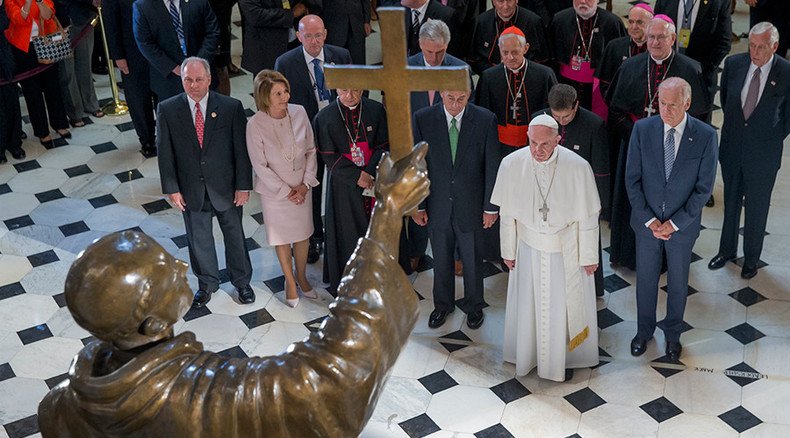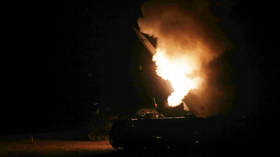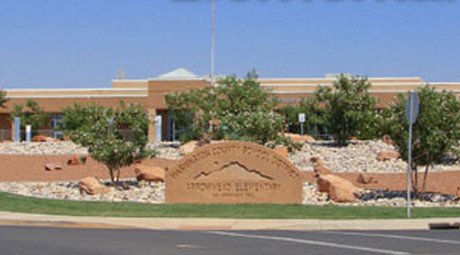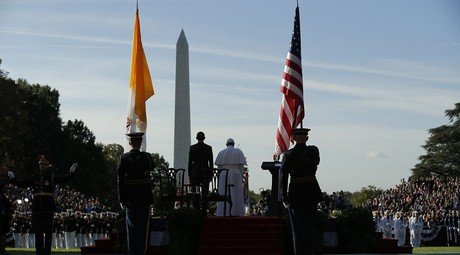Controversial saint's memorial vandalized days after Pope-led canonization ceremony

Statues and gravesites have been damaged at the Carmel Mission in California, where the remains of an18th-century Spanish missionary, Father Junipero Serra, are buried. Serra, considered a brutal colonialist by some, was canonized last week.
The perpetrators splashed paint on statues and structures at the mission's cemetery and scrawled "Saint of Genocide" on a headstone, according to the Los Angeles Times, sometime late Saturday or early Sunday, despite the presence of security guards on the mission grounds.
Vandals topple Junipero Serra statue at Carmel Mission days after he was made a saint http://t.co/sBww7vo7sjpic.twitter.com/fZmTyuZejG
— L.A. Times: L.A. Now (@LANow) September 28, 2015his vandal's not going to heaven. new saint junipero serra's statue vandalized in carmel. http://t.co/ngBHmdDkTNpic.twitter.com/Xc9mdmXiof
— Kristen Sze (@abc7kristensze) September 28, 2015Carmel Police Sgt. Luke Powell said the department is reviewing surveillance video, and that the incident is being investigated as a hate crime, since vandals chose to target "specifically the headstones of people of European descent, and not Native American descent," the LA Times reported.
“No one has claimed responsibility for the act,” Powell said.
Mass graves, genocide, destruction of peoples & cultures. But "shock" when #JuniperoSerra's statue is knocked over? http://t.co/bBuhM70q8D
— tara houska (@zhaabowekwe) September 28, 2015The Carmel Mission condemned the acts on social media.
“Pray that the people [who] did this take responsibility for their actions on this sacred property and that they seek reconciliation,” a representative for the Carmel Mission wrote on Facebook. “Let us remember that we live in a loving community and let us not be discouraged by such things. As St. Serra said, "Always look forward, never back."
READ MORE: 10 controversies swirling around Pope Francis’ visit to the US
Controversy erupted when the Vatican announced that Pope Francis would canonize Serra during his trip to the US. Serra arrived on American territories in 1749. Twenty years later, he was sent to the Pacific coast by the Spanish crown, accompanied by an army. He eventually established nine missions from San Francisco to San Diego.
However, he is accused by many of ushering in and tolerating the brutal treatment of native peoples, whom he believed were childlike heathens who had to be tamed by Catholicism. Serra's part in the violence visited upon indigenous peoples of California during this era is disputed.
Pope Francis indicated last week that Serra's legacy has been misinterpreted. The Pope said at the canonization, held on Sept. 23 in Washington, that the friar “sought to defend the dignity of the native community."
READ MORE: Pope Francis in US: Holy tour heads to Capitol Hill, NYC (PHOTOS, VIDEOS)
Opponents of the canonization, including Native American groups and scholars, said prior to the Pope's visit that the Spanish friar played an integral part in dehumanizing tribes across California, and that there were other options for the Pope to choose for the first American canonization.
“This pope doesn’t really care what we think,” Ron Andrade, the director of the Los Angeles City/County Native American Indian Commission and a Luiseño from the Lajolla Indian Reservation, told The Washington Post. “I don’t know what he is hoping to accomplish with canonizing Serra. There were better people.”
Andrade compared Serra to Hitler and the brutal Spanish conquistadors who tore through South America.
“Everywhere they put a mission the majority of Indians are gone,” Andrade told the Guardian, “and Serra knew what they were doing: they were taking the land, taking the crops, he knew the soldiers were raping women, and he turned his head.”
Andrade said Serra "decimated 90 percent of the Indian population" in his areas.
“Why doesn’t the pope canonize Pizarro or Cortez?” he added, referring to two of the most notoriously savage Spanish conquistadors who visited the Americas. “It’s dumb.”
Native Americans outside #SF Mission Dolores protest sainthood for Fr. #JuniperoSerra calling missions "oppresive" pic.twitter.com/IaFHcNj8AG
— Juan Carlos Guerrero (@JuanCarlosABC7) September 23, 2015Others have gone softer on Serra's complicity while acknowledging the violent conquest that marks his background.
“Serra was not the face of evil," Deborah Miranda, professor of literature at Washington and Lee University and an Ohlone Costanoan Esselen Indian, told the Guardian.
“But there were so many atrocities happening and he closed his eyes,” she said. “I don’t think he should be rewarded for that.”
READ MORE: Tribes struggle with toxic spill as EPA is accused of deliberate disaster
Miranda added that Serra's ambition “laid the groundwork to erase our cultures and impose this burden of shame on Indians about being Indian."
Natives turned to the missions in the face of ravaging disease and collapsing food sources dominated by Spanish agriculture. Hundreds of thousands of native died, mostly from newly-introduced diseases.
READ MORE: Arizona Apache tribe protests burial ground land-swap at US Capitol
Others, including the Pope, have called Serra a protectorate of native peoples who guarded them from marauding solidiers.
Serra “sought to defend the dignity of the native community, to protect it from those who had mistreated and abused it," the Pope said last week. "Mistreatment and wrongs which today still trouble us, especially because of the hurt which they cause in the lives of many people.
“He was the embodiment of ‘a Church which goes forth,’ a Church which sets out to bring everywhere the reconciling tenderness of God,” Francis added. “Junipero Serra left his native land and its way of life. He was excited about blazing trails, going forth to meet many people, learning and valuing their particular customs and ways of life. He learned how to bring to birth and nurture God’s life in the faces of everyone he met; he made them his brothers and sisters.”














